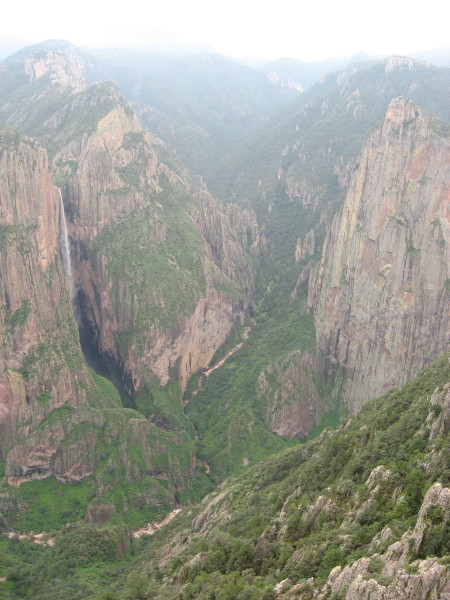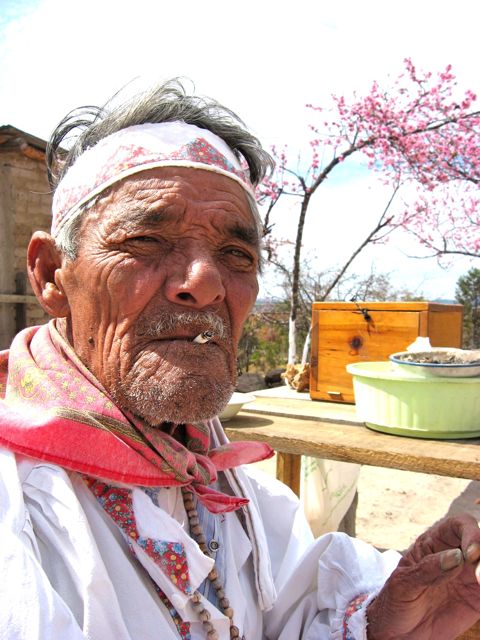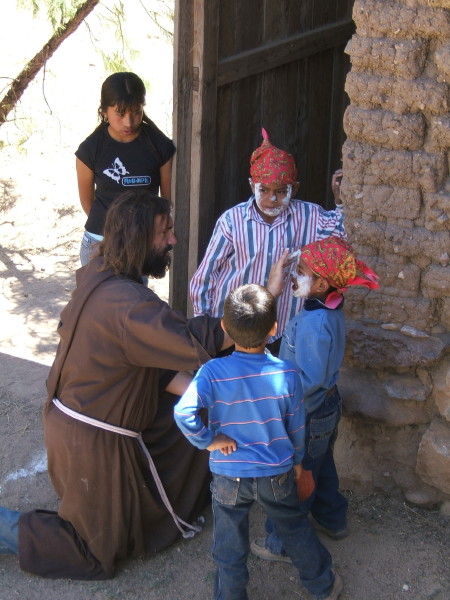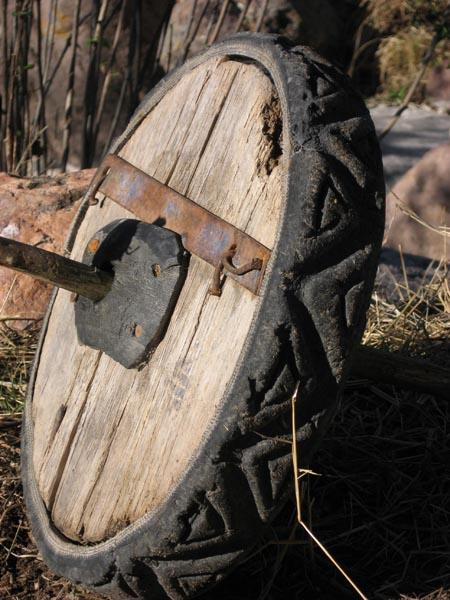Copper Canyon Trails, LLC ―
www.coppercanyontrails.org ―
1334 West Pennington Street ―
Tucson, AZ 85745 ―
Phone: 520-324-0209
Exploring Trails in the Copper Canyon
Waves of Natives: Inhabitants of the Sierra Tarahumara
CANYON COUNTRY
Piedra Volada faces El Gigante in the magnificent Baranca Candamena.
 |
The Copper Canyon area of Mexico's Sierra Madre Occidental is largely made possible by five or six major rivers, and numerous perennial tributaries that spiral on the high backbone of the continent, with all but one river system dumping its water and sediment into the Rio Fuerte and the Sea of Cortez. See this wonderful interactive map by environmentalist Rocky Contos. The Rio Conchos, just east of Creel and the continental divide, empties into the Rio Bravo ( Rio Grande) and the Gulf of Mexico. This vast, tortuous area at the junction of the states of Chihuahua, Sonora, and Sinaloa encompasses over 25,000 square miles (62,500 hectares). The volcanic tuff, primarily composed of andesite and rhyolite, is a homogenous layer up to 8000 feet (2400m) thick. Relatively young by geologic standards ( 30 million years), it offers suitable conditions for canyon walls steeper and deeper than those at the Grand Canyon of Arizona. By comparison, the Grand Canyon of Arizona by virtue of the 2000 foot upwelling of the Kaibab Plateau, exposes up to 5000 feet of distinct sedimentary layers formed by almost a billion years of erosion and deposition of sand, mud, and decomposing sea creatures overlaying a bedrock of granite and schist. In the Copper Canyon, deep fissures filled with rich intrusions of valuable minerals like silver have been known and exploited for centuries. Recently many international corporations have reopened mines mentioned by Carl Lumholtz and other early explorers of the region. For the tired hiker, however, it is the numerous hot springs that bring unexpected delight at the end of a grueling day.
PAPAGOCHI VALLEY
The Tarahumaran Indians were farming here when the Conquistadors arrived. They began to migrate to the canyons from the fertile Papagochi Valley near Cuauhtemoc about 400 years ago. As Spanish efforts to find slave labor for their silver mining operations increased, the Indians adapted to these inaccessible canyons. Outfitted with newly introduced axes and violins and goats, and a smattering of a new religion brought by the Jesuits, they began to inhabit the numerous overhangs and caves in this vast, contorted mountain range. The Papagochi River slowly flows northwest towards Madera where it enters the canyon country. The Huapoca and Sirupa Canyons are on the Papagochi. Today the Papagochi Valley is filled with apple orchards primarily owned by the Mennonites, with the Tarahumarans providing the stoop labor.
INDIGENOUS INHABITANTS
Nowadays, the Tarahumarans, or Rarámuri as they call themselves, are renowned as long distance runners. It is their indefatigable endurance that sets them apart. It is difficult to find level land for farming while living in a vertical environment. An adjacent ridge half a kilometer away as the raven flies may be 4 or 5 kilometers and 1200 feet (400 meters) away by trail. And that adjacent ridge may be less than an acre in area. They only practice dry farming, so what land they can farm may yield a meager harvest. Supplies may be in a village a day's walk away. Most Tarahumarans have goats, but not many have burros. It is a tough life. For relaxation, they have a running game called rarajipare. The participants show up to run, but nothing happens until all bets are placed. A team of women measure the value of bets against like bets. Chickens, goats, bolts of cloth, buttons and ribbon, hatchet and axe heads are all carefully appraised and sorted and stacked. Generally, towards the end of the day the race begins. A carved wooden ball about 15 cm in diameter is dropped on the ground. It is moved on a predetermined course of a few kilometers by foot, but participants have hooked sticks to get it loose when it gets stuck. The race may go on all night; by torchlight and moonlight. Racers are allowed to be paced, and may be encouraged or chided by somebody with a big wager. The winner is the last man standing. The women also have a running game called ahuehuete. They move a hoop along with stick, and it's a great treat to see all those women running with their big, colorful skirts.
Tarahumara Curandero prepares for a Ceremony.
 |
These races aren't without their sponsors. The main promotional product is Tesguino, a crude, low alcohol corn beer. It takes about 5 days to ferment a batch, so its slightly sour flavor is similar to the clear whey floating on top of a tub of plain yogurt. Usually there is someone who puts on the race after an activity, such as trail repair, judicial meetings, or religious festivities. This person has the resources and responsibility for making the beer, and timing its peak flavor to coincide with the end of work; and the beginning of fun. The Tarahumara are actually a very shy, solitary people, and these gathering punctuated by "ponche" are the lubricant of social interaction. This social beer culture has been exhaustively researched. See the reading list, or look for Tarahumara of the Sierra Madre: Beer, Ecology, and the Social Organization, John G. Kennedy, Ⓒ 1978; ISBN 0882956159
The Tarahumarans were not the original inhabitants of the canyons, however. Numerous ruins from the Mogollon culture dot the landscape if you know where to look. The Fremont-Anasazi-Mogollon could have been a wave of migration about 1200 years ago-the third, and most recent wave. Paquime is the most famous of the northern Mexico plains settlements, located near the present-day city of Nuevas Casas Grandes. It is comparable to the Chaco Canyon system of New Mexico. Abandoned cliff dwellings are everywhere with the most extensive being Cuarenta Casas near the logging town of Madera. The cliff dwelling ruins contrast with Mesa Verde and Tsegi in the Four Corners region of the southwest US.
MENNONITES AND THE REVOLUTION
Today the Papagochi plains are the apple basket of Mexico. Many stone fruits are also grown. Tarahumarans now labor in the orchards. Anyone arriving in the Sierras from the east will notice hectares (one hectare equals 2.5 acres) of apple orchards. Thousands of tall, slim poles flank their perimeter holding nets that are pulled over the trees in case of bad weather. Although susceptible to snow, this region is more frequently hit by fierce hail storms during the summer monsoons. Enumerable smudge pots burn on cold nights to protect the fruit from the relentless winds on the high, almost treeless plains.
Cuauhtemoc, an hour west of Chihuahua, and about 3 hours east of Creel, is the unofficial capital of the Mennonite community. A statue at the western edge of town features a farmer wearing his signature bib overalls standing beside a thigh-high milk can, holding aloft a sheath of grain. Following the Mexican Revolution that ended in 1920, President Alvaro Obregon invited the Mennonites from Canada. The revolution was primarily a result of consolidation of vast tracts of land into the hands of a few wealthy families to the exclusion and dispossession of the peasants. Emiliano Zapata was the leader from the central state of Morelos, and Pancho Villa was the general of the Division of the North centered in Chihuahua. 2010 is the 100th anniversary. Viva la Revolucion! One of the ousted landholders was William Randolph Hearst. He had only constructed the footing of has hacienda near present day Babicora, when he had to flee to San Clemente, CA.
The revolution emptied, and opened up lots of land. The Mexican government promised the Mennonites autonomy, freedom from military service and taxes. The Canadian government had previously reneged on its promise not to require military service of the followers of Menno Simons (1496-1561) of Friesland, now in the Netherlands. These Anababtists generally attain only a sixth grade education in an effort to limit the influence of the outside world and foster spiritual communities that live close to the soil. They maintain their genetic integrity by marrying within the community. Many people do a double-take when they see blonde blue eyes kids on the streets of Cuauhtemoc. They still speak low German, but the men especially speak Spanish for commerce. The Mennonites embrace technology but eschew adornments. Their products are known for their quality and sought throughout Mexico. Especially famous is Mennonite cheese. They also make tasty peanut butter and chocolate. Mennonite families live in Campos and produce goods similar to a guild society. Campos lining the highway have specialties such as double-pane windows, solar hot water heaters, woodstoves, or swingsets. While in the area, don't miss a chance to try Jugo Mennonita, an indescribable cocktail of cabbage, garlic, and prickly pear cactus...it's more like a tonic, than a juice. I hope to get enough gumption to try it one of these days!
JESUITS AND ADELANTADOS
Jesuit Priest Father David near Yepachic, Chihuahua.
 |
Silver was first mined in Mexico at Taxco in 1522. Mining in Batopilas began in 1632 (See Mineralogical Record, V17, #1, pp 61-80; Jan-Feb 1986) after advance guards discovered gleaming silver in the banks of the river. At one point the population of this sleepy town was over 5000. It was the second city in Mexcio to have electricity thanks to the efforts of disgraced Washington, D.C. governor Alexander Sheppard. Meanwhile, the Jesuits slowly worked their way up the west coast of Mexico. They settled on the rivers among the natives, and began by learning their languages and teaching them agricultural improvements. They encouraged reducciones, a process whereby the natives were concentrated in a location to donate labor to build a church. Mine owners recognized the availability of a defenseless and pliable population and sought to enslave the Indians. Families were treated harshly and separated from one another. The Jesuits were recalled to Spain in 1767. The Spanish Crown feared they were getting too rich and powerful. Not all the Indians were Christians when they left. As they Indians left the plains for the refuge of the canyons, the religion they carried morphed into an amalgamation of paganism, animism, and Christianity. Today their Easter celebrations are a big draw for foreigners and Mexicans alike.
MINING AND LUMBER
At an elevation of over 8000 feet, the spine of the Sierra Madre is clad in a mantle of conifers. Lower down, the slopes of the Apachean Madrean woodland are home to over 100 species of oak. On our hikes it is easy to differentiate 4 or 5 kinds of scrub oak by their leaf size alone. Some have manzanita size leaves while others have the Nature Conservancy logo type leaves. Although the area is steep, it has been heavily harvested twice for lumber. It was clearcut where feasible. Luckily, due to the nature of the terrain and the lack of financial resources, most of it was selectively cut. Only the largest and tallest tress were felled. This allowed the forest optimal conditions to grow. Also without "firewood gathering" restrictions, the forest floor is practically clear of downfall. The area is honeycombed with logging roads. Many of these haven't been used in 50 years and make for great hiking trails or singletrack biking. Sawmills abound in the area. Some have moved on and left only mountains of sawdust. Illegal sawmills are also a problem but in an area suffering from unemployment, the locals are happy for any work.
Recently several new mines have opened, and old mines are being reworked. The techniques haven't changed much, but he higher price of gold has made the ore extraction more economically feasible. Heap leach mining is the preferred method. Unfortunately it uses cyanide and mercury to remove gold. The used chemicals percolate into the soil or wash into the watershed during monsoons. There again, it brings lots of work for low wages, and introduces a plethora of ailments.
RELIGION, HEALTH, and EDUCATION
A Tarahumara Child's Push Toy Imitates Dad's Wheelbarrow.
 |
The Tarahumara suffer high infant mortality. They aren't well integrated into the cash economy, and hospitals are far away. In the rancherias that have a church, there is usually a visiting doctor and a preacher. The doctor dispenses medication for ailments, but there is usually only enough for a few days. Even a regimen of antibiotics can't be completed. Medical care is free, but you get what you pay for. Prenatal care, postnatal care, general hygiene, dental education, nutritional information are all lacking. Coca Cola makes fast inroads but toothbrushes and toothpaste don't. Cookies are fortified with vitamins and minerals, but processed foods such as lighly salted Maruchan are taking a toll on their general health. The preacher visits about as often as the doctor. He offers baptisms, and records births, deaths, and marriages. Many Indians still rely on the medicine man or curandero, but tuberculosis and other respiratory ailments can't be cured by faith. The women still cook with fires, and they usually have a baby in the rebozo on their back. The particulate matter they breathe is bad for the healthy, but detrimental for the very young and very old. The good thing about their poorly insulated houses is that they are well ventilated. They use their houses mainly to store belongings that they want to keep away from their goats.
TOURISM
Tourism is a mixed blessing. It offer the Indians a way to make a living without changing their lifestyle. But by bringing outside ideas and cash into a traditionally corn based economy, their lifestyle is changing. The men have acculturated to a much higher degree than the women. The men have adopted pants and western style shirts instead of their pleated white muslin blouses. They wear boots instead of the traditional huaraches, and belts instead of the woven mohuaca. The woven pattern of the mohuaca indicates the wearers village or region. It is getting more difficult to find traditionally dressed men, but some still wear traditional clothing for the fiestas, and luckily the traditional loincloth is more comfortable than pants in the deep, hot canyons. Many Tarahumarans leave for towns like Cuauhtemoc to find seasonal jobs like picking apples. The women still wear their full, brightly colored skirts.
Escorted Hikes and Burro Expeditions in Mexico's Copper Canyon
Copper Canyon Trails, LLC ―
www.coppercanyontrails.org ―
Phone: 520-324-0209



